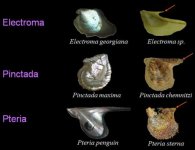CortezPearls
PG Forum Admin
Actually it is:
Family Pteriidae (double "i")
Genus Pteria: with the most commonly recognized species being Pteria penguin and P. sterna.
Genus Pinctada: with many commercial species, but mainly P. imbricata (=fucata) or "Akoya", P. maxima (Silver/Gold lip), P. margaritifera (Black-lip) and P. mazatlanica (Panamic Black-Lip).
Now, everyone knows about these...but it seems most are forgetting about the third Genus... Electroma
This group is mostly forgotten because it has only 7 species and they are small and thus considered "non-commercial".
Family Pteriidae (double "i")
Genus Pteria: with the most commonly recognized species being Pteria penguin and P. sterna.
Genus Pinctada: with many commercial species, but mainly P. imbricata (=fucata) or "Akoya", P. maxima (Silver/Gold lip), P. margaritifera (Black-lip) and P. mazatlanica (Panamic Black-Lip).
Now, everyone knows about these...but it seems most are forgetting about the third Genus... Electroma
This group is mostly forgotten because it has only 7 species and they are small and thus considered "non-commercial".



